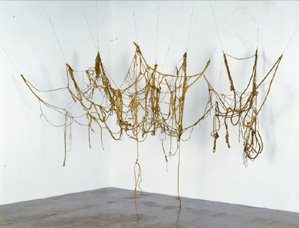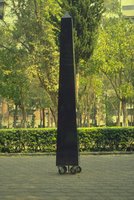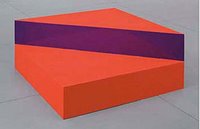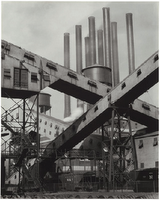Tuesday, May 30, 2006
True Love 4 Eva
We finally saw Eva Hesse's work in person. We had seen plenty in slide lectures, web photos, and magazines, and always admired it. This show also led us for the first time to the Jewish Museum.
Accretion looked great in the space. A slight reveal between the wall and floor creates a thin black line behind the fiberglass tubes, helping to emphasize their silhouettes and the voids between them.
Sans II stretches across the long wall, five modules cast in fiberglass and resin. As each of the modules is in a different collection - two at the Whitney - they deteriorate at varying rates. On the wall, we can see the color change through the series, like East Coast pallor to Mediterranean tan. Evidence of her studies with Josef Albers? We can also see the surfaces weathering, becoming flaky and reptilian.
The turds/meatballs on the grid of Schema reveal a truth about EH. She occupies The Grid - geometric, orderly, rational - and subverts it with all-too-human imperfections - unusual forms, secondary and tertiary colors, and messy textures.


We struggled with the wall label for Contingent. EH said, "I wanted to get to an art non connective, non anthropomorphic, non geometric, non, nothing, everything." How can she deny the anthropomorphic content of this piece? The color connotes flesh, as does the texture - as it is in most of her work at this show. In Connection, the individual components hang like Peking Ducks in Chinatown. This piece also makes special use of gravity in its construction, as the fiberglass relies on dripping for its formation. It's a record of its own construction, something we rarely find in sculpture, but often in painting.
Creating something that records its own progress and records gravity brings Hesse into painting, face-to-face with Pollock. Everyone knows the connection betweenUntitled (Rope Piece) and a Pollock drip painting. We can review how they use space: Pollock announces himself in space by his mural-size scale. Hesse infiltrates three dimensions - four if you count light. The ropes connect one wall to its perpendicular neighbor, and then to the floor, which they reach down to kiss. Shadows cast all over, creating a one-dimensional doppelganger of the sculpture. Individual ropes defy gravity, others bend to it, and the entire structure seems to float. Or explode. The ropes reach above the viewer and beneath the viewer, like a giant spiderweb lunging forward.

Accretion looked great in the space. A slight reveal between the wall and floor creates a thin black line behind the fiberglass tubes, helping to emphasize their silhouettes and the voids between them.
Sans II stretches across the long wall, five modules cast in fiberglass and resin. As each of the modules is in a different collection - two at the Whitney - they deteriorate at varying rates. On the wall, we can see the color change through the series, like East Coast pallor to Mediterranean tan. Evidence of her studies with Josef Albers? We can also see the surfaces weathering, becoming flaky and reptilian.
The turds/meatballs on the grid of Schema reveal a truth about EH. She occupies The Grid - geometric, orderly, rational - and subverts it with all-too-human imperfections - unusual forms, secondary and tertiary colors, and messy textures.


We struggled with the wall label for Contingent. EH said, "I wanted to get to an art non connective, non anthropomorphic, non geometric, non, nothing, everything." How can she deny the anthropomorphic content of this piece? The color connotes flesh, as does the texture - as it is in most of her work at this show. In Connection, the individual components hang like Peking Ducks in Chinatown. This piece also makes special use of gravity in its construction, as the fiberglass relies on dripping for its formation. It's a record of its own construction, something we rarely find in sculpture, but often in painting.
Creating something that records its own progress and records gravity brings Hesse into painting, face-to-face with Pollock. Everyone knows the connection betweenUntitled (Rope Piece) and a Pollock drip painting. We can review how they use space: Pollock announces himself in space by his mural-size scale. Hesse infiltrates three dimensions - four if you count light. The ropes connect one wall to its perpendicular neighbor, and then to the floor, which they reach down to kiss. Shadows cast all over, creating a one-dimensional doppelganger of the sculpture. Individual ropes defy gravity, others bend to it, and the entire structure seems to float. Or explode. The ropes reach above the viewer and beneath the viewer, like a giant spiderweb lunging forward.

Tuesday, May 23, 2006
Dungeon Art
The Triple Diesel crew stumbled into this readymade, post-Minimalist, goth sculpture.


It's like Nayland Blake and Banks Violette, or even Sol LeWitt after a night at the Batcave. The yellow pillow killed us. And it's on wheels!
It was alone there, on the sidewalk, under the spooky spotlight of the streetlamp.



It's like Nayland Blake and Banks Violette, or even Sol LeWitt after a night at the Batcave. The yellow pillow killed us. And it's on wheels!
It was alone there, on the sidewalk, under the spooky spotlight of the streetlamp.

Thursday, May 18, 2006
Hue Go-Bots
The TD crew attended audio-visual presentations at the Guggenheim last night by Hugo Boss Prize nominees Damian Ortega and Aida Ruilova. 2006 marks the tenth year since the inception in 1996 of the biennial award.
We knew Aida Ruilova pretty well from her 5-monitor installation at the 2004 Whitney Biennial, Greater NY, a show at Greenberg Van Doren, and drawings in places like Scott Hug's K48 magazine. But she's been in major shows all over the world - even the Venice Biennale and current Berlin Biennial. We didn't see Julian LaVerdiere - are they still boyfriend and girlfriend?

Aida isn't much of a public speaker, but her videos are riveting. Throughout her oeuvre, percussive and rhythmic sound adds as much structure to the videos as the editing, even essential in some videos, like the inhaling exhaling waves in "Untitled." Gasps and ejaculations repeat until they become beats, turning the videos into aural fugues. Her new video - the longest so far - honors her mentor Jean Rollin, a French director of horror/vampire films: Rollin, Ruilova's Rosetta. In this video, Rollin plays dead on a bed while a young woman mourns him. She mounts him and unzips his pants, suggesting fellatio and necrophilia. It's Elektra complex and the anxiety of influence, via the macabre. Interspersed through this narrative are shots of cemeteries, castles, and a scholar's library, along with creepy dead girls. In this video, Ruilova indulges more in the vampire imagery she had earlier evaded. That evasion validated her horror aesthetic, by shaking the genre stereotypes. Here, we suppose it's okay, since she's doing an homage to Rollin.
Damian Ortega, new to us, really knocked our calcetines off. His presentation began with "Tired Pickaxe," a sculpture of an axe bent along the handle. The pickaxe lays on the sidewalk, yet isn't prostrate - it curves up, as if struggling to get up, or maybe resigning after a long day. We thought of that bent streetlamp done by Martin Kippenberger.

This surrealist, sculptural strategy surfaces again in the series of Coca-Cola bottles blown to imitate female figures. Other work was more rule-based and Minimalist. 50 numbered cinderblocks were stacked in a grid. Onto this wall, he painted an auto battery bearing the name "America." Then he reordered the grid in varied directions, which caused the battery image to become reconfigured. And then in other projects, he examines how function separates an object from a sculpture "Obelisk on Wheels" is a moving - so unreliable - landmark. "Cosmic Thing" disassembles and then suspends the components of a Volkswagen Beetle, an apotheosis from mundane vehicle to sculptural spectacle.

Still convinced about "the expanded field," we appreciate how Ortega's sculptures merge with architecture and wonder if Ruilova's efforts in film and music suggest an analogous "expanded field" for video.


We knew Aida Ruilova pretty well from her 5-monitor installation at the 2004 Whitney Biennial, Greater NY, a show at Greenberg Van Doren, and drawings in places like Scott Hug's K48 magazine. But she's been in major shows all over the world - even the Venice Biennale and current Berlin Biennial. We didn't see Julian LaVerdiere - are they still boyfriend and girlfriend?

Aida isn't much of a public speaker, but her videos are riveting. Throughout her oeuvre, percussive and rhythmic sound adds as much structure to the videos as the editing, even essential in some videos, like the inhaling exhaling waves in "Untitled." Gasps and ejaculations repeat until they become beats, turning the videos into aural fugues. Her new video - the longest so far - honors her mentor Jean Rollin, a French director of horror/vampire films: Rollin, Ruilova's Rosetta. In this video, Rollin plays dead on a bed while a young woman mourns him. She mounts him and unzips his pants, suggesting fellatio and necrophilia. It's Elektra complex and the anxiety of influence, via the macabre. Interspersed through this narrative are shots of cemeteries, castles, and a scholar's library, along with creepy dead girls. In this video, Ruilova indulges more in the vampire imagery she had earlier evaded. That evasion validated her horror aesthetic, by shaking the genre stereotypes. Here, we suppose it's okay, since she's doing an homage to Rollin.
Damian Ortega, new to us, really knocked our calcetines off. His presentation began with "Tired Pickaxe," a sculpture of an axe bent along the handle. The pickaxe lays on the sidewalk, yet isn't prostrate - it curves up, as if struggling to get up, or maybe resigning after a long day. We thought of that bent streetlamp done by Martin Kippenberger.

This surrealist, sculptural strategy surfaces again in the series of Coca-Cola bottles blown to imitate female figures. Other work was more rule-based and Minimalist. 50 numbered cinderblocks were stacked in a grid. Onto this wall, he painted an auto battery bearing the name "America." Then he reordered the grid in varied directions, which caused the battery image to become reconfigured. And then in other projects, he examines how function separates an object from a sculpture "Obelisk on Wheels" is a moving - so unreliable - landmark. "Cosmic Thing" disassembles and then suspends the components of a Volkswagen Beetle, an apotheosis from mundane vehicle to sculptural spectacle.

Still convinced about "the expanded field," we appreciate how Ortega's sculptures merge with architecture and wonder if Ruilova's efforts in film and music suggest an analogous "expanded field" for video.


Wednesday, May 17, 2006
Google trends
The TD crew has had a blast with Google's new feature, Google Trends. One can search for something and then see who else searches for it.
"Sex," naturally the first choice, seems to attract Islamic countries: Egypt, India, and Turkey.
"Andy Warhol" is popular in Pittsburgh - the Museum - and then UK cities. New York is only the fifth highest Warhol seeker. But it's numero uno in searching for "Edie Sedgwick" and "Candy Darling."

"Kippenberger" is most popular in Europe, especially in Berlin, Cologne, and Hamburg; again, NY is fifth.
Denver, Philadelphia, and San Diego lead searches for "Sistine Chapel." "Van Gogh" is sought after by Santiago, Amsterdam, and Buenos Aires. "Ana Mendieta" is popular in Miami, NYC, and London. The top ten searchers for "Piero della Francesca" are in Italy, except for Paris.
"Triple Diesel Crew" produced no results; same for "TD Posse" and "TD Krew." We'd like to hear how you fared.

"The Searchers" is popular in Birmingham, UK; London, Manchester, and Sydney. Nothing in the U.S. Western states, except for L.A.
"Sex," naturally the first choice, seems to attract Islamic countries: Egypt, India, and Turkey.
"Andy Warhol" is popular in Pittsburgh - the Museum - and then UK cities. New York is only the fifth highest Warhol seeker. But it's numero uno in searching for "Edie Sedgwick" and "Candy Darling."

"Kippenberger" is most popular in Europe, especially in Berlin, Cologne, and Hamburg; again, NY is fifth.
Denver, Philadelphia, and San Diego lead searches for "Sistine Chapel." "Van Gogh" is sought after by Santiago, Amsterdam, and Buenos Aires. "Ana Mendieta" is popular in Miami, NYC, and London. The top ten searchers for "Piero della Francesca" are in Italy, except for Paris.
"Triple Diesel Crew" produced no results; same for "TD Posse" and "TD Krew." We'd like to hear how you fared.

"The Searchers" is popular in Birmingham, UK; London, Manchester, and Sydney. Nothing in the U.S. Western states, except for L.A.
Thursday, May 11, 2006
Congratulations, graduate

The TD crew occupied seats at Radio City Music Hall yesterday for the graduation ceremony.
The President's speech criticized the Brooklyn Parks Department for closing and censoring Brooklyn College's MFA thesis show and confiscating, damaging, and losing student artwork. He also condemned Brooklyn College for submitting and not defending its students. We silently thanked him for mentioning the students' blog and reminding the audience members of the threat of philistinism in powerful places.
We had an hour to kill after the ceremony and visited the Biennial for the second time. Awesome cartoonists Matt Madden and Jessica Abel were there, checking it out. The TD crew dug Matthew Monahan's sculptures, Robert Gober's photos, Mark Bradford's epic collages, Urs Fischer's macabre candles, Paul Chan's tragic projection, and Jutta Koether's liquid glass paintings. After our next visit, we'll try to post something more substantial about the Biennial.
Yeah, so graduation. All done with our grad program. How is it that we are still such simpletons?
Tuesday, May 09, 2006
Outside the Box
We keep thinking about the Donald Judd mini-retrospective at Christie's. It was our first time seeing so many Judd sculptures in sequence.
Prior to this experience, we saw in Judd only the cool, mechanical, precise, architectonic, analytic, orderly, and measured qualities - "typical male." It was like talking to an engineer in the family.

But atop the Simon & Schuster building, in a freshly painted, loft-like space with brick walls, the tranquil atmosphere and wealth of natural daylight illuminated Judd in ways we had missed.
Judd understood color. A seemingly black plexiglas panel bounced color around the interior of a steel box, unveiling evergreen, purple, and blue, complementing the nearby echoes of an orange panel. A wall piece made of green boxes and red boxes reflected each on the other producing rich grays where they met. The glass panels in "Untitled" (1990) were prismatic, capturing the light rays passing through the room, and when we stooped low to look up through the sculpture, we discovered a mesmerizing moire of metal and mirrors. Pacing back and forth before "Untitled" (1974), was like inspecting Army privates in rank and file. The steel and red interiors took on personality (or antipersonality?), becoming square-jawed soldiers called to impenetrable attention, each barking the same hearty-but-rigid response.
Judd cobbled with the details. His socket screws are not aligned, but the others, as in the steel sculptures, are. How contrary to the masculine "grand gesture," to twist bolts into rows, yet how paternal to oversee and maintain these orderly systems. Yes, it's about macho intimidation, but it's also about a patrician standard, like an obsession with hygiene and habits.

It was funny to see scuff marks on "Untitled" (1988), a red plywood and Plexiglas object on the floor. Our detective proposed that visitors had poked at the piece with their feet, like tires on a car at an auto dealer.
We always enjoy the auction house preview exhibitions, for the chance to see work up close, to catch it before it disappears into someone's living room or warehouse. But this afternoon was extra special.
Prior to this experience, we saw in Judd only the cool, mechanical, precise, architectonic, analytic, orderly, and measured qualities - "typical male." It was like talking to an engineer in the family.

But atop the Simon & Schuster building, in a freshly painted, loft-like space with brick walls, the tranquil atmosphere and wealth of natural daylight illuminated Judd in ways we had missed.
Judd understood color. A seemingly black plexiglas panel bounced color around the interior of a steel box, unveiling evergreen, purple, and blue, complementing the nearby echoes of an orange panel. A wall piece made of green boxes and red boxes reflected each on the other producing rich grays where they met. The glass panels in "Untitled" (1990) were prismatic, capturing the light rays passing through the room, and when we stooped low to look up through the sculpture, we discovered a mesmerizing moire of metal and mirrors. Pacing back and forth before "Untitled" (1974), was like inspecting Army privates in rank and file. The steel and red interiors took on personality (or antipersonality?), becoming square-jawed soldiers called to impenetrable attention, each barking the same hearty-but-rigid response.
Judd cobbled with the details. His socket screws are not aligned, but the others, as in the steel sculptures, are. How contrary to the masculine "grand gesture," to twist bolts into rows, yet how paternal to oversee and maintain these orderly systems. Yes, it's about macho intimidation, but it's also about a patrician standard, like an obsession with hygiene and habits.

It was funny to see scuff marks on "Untitled" (1988), a red plywood and Plexiglas object on the floor. Our detective proposed that visitors had poked at the piece with their feet, like tires on a car at an auto dealer.
We always enjoy the auction house preview exhibitions, for the chance to see work up close, to catch it before it disappears into someone's living room or warehouse. But this afternoon was extra special.
Monday, May 08, 2006
Sing Sing (Ain't Got that Swing)
The TD posse took a fast train to Sing Sing Prison this weekend. We were in big trouble!

Actually, our friend is a volunteer art teacher at the prison, and invited us to see the inmates' art exhibition and stage show. The event was produced by an organization called "Rehabilitation through the Arts (RTA)" the name of which explains itself. Aside from making art, some inmates even earn college degrees while serving time (although no MFAs). Drawings and paintings ranged from tightly rendered, illustrative caricatures of rappers to poignant reflections on the prison experience. One prisoner drew the scene from his window, and then placed a box over the drawing, leaving only a narrow slot for viewing the picture. We understood the statement about constriction, and also recalled Duchamp's "Etants Donnes." One inmate even adhered found objects - a bundle of sticks (a faggot?) - to paper. This year's stage show was based in dramatic improvisation and music, but previous episodes featured "12 Angry Men" and even plays authored by inmates.
Naturally, but regrettably, cameras are prohibited of visitors to Sing Sing, as are sketchbooks and pencils. Actually, everything is prohibited. So use your imagination, as we use our memory.
The experience was a moral dilemma for us. We admired the inmates' rehabilitative efforts and earnest performances before strangers. On the other hand, we felt animosity towards these men who had committed violent crimes, and worried about how their victims' families. In the end, we concluded that we could support the rehabilitative programs, if not the inmates.

Actually, our friend is a volunteer art teacher at the prison, and invited us to see the inmates' art exhibition and stage show. The event was produced by an organization called "Rehabilitation through the Arts (RTA)" the name of which explains itself. Aside from making art, some inmates even earn college degrees while serving time (although no MFAs). Drawings and paintings ranged from tightly rendered, illustrative caricatures of rappers to poignant reflections on the prison experience. One prisoner drew the scene from his window, and then placed a box over the drawing, leaving only a narrow slot for viewing the picture. We understood the statement about constriction, and also recalled Duchamp's "Etants Donnes." One inmate even adhered found objects - a bundle of sticks (a faggot?) - to paper. This year's stage show was based in dramatic improvisation and music, but previous episodes featured "12 Angry Men" and even plays authored by inmates.
Naturally, but regrettably, cameras are prohibited of visitors to Sing Sing, as are sketchbooks and pencils. Actually, everything is prohibited. So use your imagination, as we use our memory.
The experience was a moral dilemma for us. We admired the inmates' rehabilitative efforts and earnest performances before strangers. On the other hand, we felt animosity towards these men who had committed violent crimes, and worried about how their victims' families. In the end, we concluded that we could support the rehabilitative programs, if not the inmates.
Thursday, May 04, 2006
Geometric non-serendipity
Triple Diesel tries hard to avoid "absolute" responses. No art is utterly hopeless and bad, and no art is unspeakably triumphant and great.

So here are some things we liked about Brian Alfred's paintings at Mary Boone Chelsea:
1.)Internal Scale: it's exciting to see how composition can add monumentality to a painting, even in the face of modest subject matter.
2.)Commitment: Alfred is unwavering in his commitment to clean, sterile spaces and surfaces in his razor-sharp city- and landscapes. Why? Dunno, but "commitment" is a content-free attribute.
3.) Titles: despite the impersonal paint application, Alfred selects heartfelt titles that reveal wonder and surprise: "The Saddest Day of My Youth" and "The Most Beautiful Night I Can Remember."
On the other hand, terms like "beautiful" - especially in a title - betray a conservative view of aesthetics and possibly philistinism. What is really beautiful? Daisies? Elizabeth Hurley? It's an underdefined term that nobody - especially an artist - should use it, except as a shorthand in persiflage. Anyway, a night sky is more "sublime" than "beautiful."
Brian Alfred's paintings explore the same things as American Modernism and Regionalism: the post-industrial city, dynamic cityscapes, and technological progress. We can think of Benton's "America Today" murals, Sheeler's precisonist pictures, or Demuth's, and even Stuart Davis abstractions. But someone like Sheeler was able to cultivate that clean control and order without stifling the image. His precisionist interiors and exteriors are still murky and mysterious, smelling of soot. The Ford Motors Plant photo series elaborated this ability. Stuart Davis' geometric abstractions never suffer the suffocating sterility of these Alfred paintings. The Davis' are lively jazz pieces, buzzing with vitality.


Brian Alfred's contemporaries include Benjamin Edwards and Kevin Zucker. The polygon and perspective zones of Edwards are dazzlingly complex. And Zucker's analytic, ascetic mixed media interiors and furniture pieces tune in to architecture more astutely, as well as challenging the conventions of painting. How about Kristin Baker's Nascar crashes, where acrylic patches slip over each other and only suggest the larger picture, like through a prism? We could even consider Lane Twitchell, who implodes city-inspired images into kaleidoscopic, multi-layered, labor-intensive collages that look like butterflies, tribal tattoos, doilies, gazebos, veils, and the sun, all processed through a blender and fractal transmogrifier.

But Brian Alfred just settles for programmatic application of his acrylic colors and large scale. That's why we struggle to avoid our least favorite adjective - "boring" - and hurry on to another show. These paintings can go in a bank lobby.

So here are some things we liked about Brian Alfred's paintings at Mary Boone Chelsea:
1.)Internal Scale: it's exciting to see how composition can add monumentality to a painting, even in the face of modest subject matter.
2.)Commitment: Alfred is unwavering in his commitment to clean, sterile spaces and surfaces in his razor-sharp city- and landscapes. Why? Dunno, but "commitment" is a content-free attribute.
3.) Titles: despite the impersonal paint application, Alfred selects heartfelt titles that reveal wonder and surprise: "The Saddest Day of My Youth" and "The Most Beautiful Night I Can Remember."
On the other hand, terms like "beautiful" - especially in a title - betray a conservative view of aesthetics and possibly philistinism. What is really beautiful? Daisies? Elizabeth Hurley? It's an underdefined term that nobody - especially an artist - should use it, except as a shorthand in persiflage. Anyway, a night sky is more "sublime" than "beautiful."
Brian Alfred's paintings explore the same things as American Modernism and Regionalism: the post-industrial city, dynamic cityscapes, and technological progress. We can think of Benton's "America Today" murals, Sheeler's precisonist pictures, or Demuth's, and even Stuart Davis abstractions. But someone like Sheeler was able to cultivate that clean control and order without stifling the image. His precisionist interiors and exteriors are still murky and mysterious, smelling of soot. The Ford Motors Plant photo series elaborated this ability. Stuart Davis' geometric abstractions never suffer the suffocating sterility of these Alfred paintings. The Davis' are lively jazz pieces, buzzing with vitality.


Brian Alfred's contemporaries include Benjamin Edwards and Kevin Zucker. The polygon and perspective zones of Edwards are dazzlingly complex. And Zucker's analytic, ascetic mixed media interiors and furniture pieces tune in to architecture more astutely, as well as challenging the conventions of painting. How about Kristin Baker's Nascar crashes, where acrylic patches slip over each other and only suggest the larger picture, like through a prism? We could even consider Lane Twitchell, who implodes city-inspired images into kaleidoscopic, multi-layered, labor-intensive collages that look like butterflies, tribal tattoos, doilies, gazebos, veils, and the sun, all processed through a blender and fractal transmogrifier.

But Brian Alfred just settles for programmatic application of his acrylic colors and large scale. That's why we struggle to avoid our least favorite adjective - "boring" - and hurry on to another show. These paintings can go in a bank lobby.
